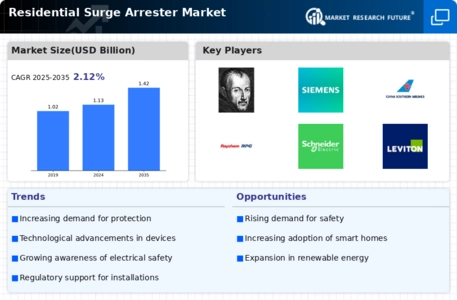Rising Incidence of Power Surges
The increasing frequency of power surges due to various factors such as extreme weather events and aging infrastructure is a primary driver for the Residential Surge Arrester Market. Power surges can cause significant damage to household appliances and electronic devices, leading to a growing consumer demand for protective solutions. According to recent data, power surges can result in losses amounting to billions annually, prompting homeowners to invest in surge protection devices. This trend indicates a heightened awareness among consumers regarding the importance of safeguarding their electrical systems, thereby propelling the growth of the Residential Surge Arrester Market. As more individuals recognize the potential risks associated with power surges, the market is likely to expand, driven by the need for reliable surge protection solutions.
Regulatory Mandates and Standards
Regulatory mandates and standards play a crucial role in shaping the Residential Surge Arrester Market. Governments and regulatory bodies are increasingly implementing standards that require the installation of surge protection devices in residential buildings. These regulations aim to enhance electrical safety and reduce the risk of damage from power surges. Compliance with such standards is becoming a prerequisite for new constructions and renovations, thereby driving demand for residential surge arresters. Market analysis indicates that regions with stringent regulatory frameworks witness higher adoption rates of surge protection devices. As these regulations continue to evolve, the Residential Surge Arrester Market is expected to expand, as manufacturers and consumers alike adapt to meet compliance requirements.
Growing Awareness of Electrical Safety
There is a notable increase in consumer awareness regarding electrical safety, which serves as a significant driver for the Residential Surge Arrester Market. Educational campaigns and initiatives by various organizations have highlighted the risks associated with electrical surges and the importance of protective devices. This heightened awareness is reflected in the rising sales of surge arresters, as homeowners become more proactive in safeguarding their electrical systems. Data indicates that regions with robust electrical safety campaigns have seen a marked increase in the adoption of surge protection devices. As consumers continue to prioritize safety in their homes, the Residential Surge Arrester Market is likely to experience sustained growth, driven by informed purchasing decisions.
Increased Adoption of Smart Home Technologies
The proliferation of smart home technologies is significantly influencing the Residential Surge Arrester Market. As households increasingly integrate smart devices, the demand for reliable surge protection becomes paramount. Smart home systems, which often include sensitive electronics, require robust protection against voltage spikes to ensure their longevity and functionality. Market data suggests that the smart home market is projected to grow substantially, with millions of new devices being installed each year. This growth directly correlates with the rising need for residential surge arresters, as homeowners seek to protect their investments in smart technology. Consequently, the Residential Surge Arrester Market is poised to benefit from this trend, as consumers prioritize the safety and reliability of their interconnected devices.
Technological Innovations in Surge Protection
Technological advancements in surge protection devices are significantly influencing the Residential Surge Arrester Market. Innovations such as improved materials, enhanced response times, and integrated monitoring systems are making surge arresters more effective and user-friendly. These advancements not only increase the reliability of surge protection but also appeal to tech-savvy consumers who seek modern solutions for their homes. Market data suggests that the introduction of smart surge protectors, which can communicate with home automation systems, is gaining traction among consumers. As technology continues to evolve, the Residential Surge Arrester Market is likely to benefit from the introduction of new and improved products that meet the changing needs of homeowners.


















Leave a Comment